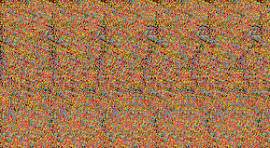Unveiling the Enchantment of 3D Image Illusions
The Fascinating World of 3D Image Illusions
3D image illusions, also known as stereograms or autostereograms, have captivated audiences for decades with their mesmerising ability to create the illusion of depth and three-dimensionality on a flat surface. These optical illusions challenge our perception and invite us to see beyond the ordinary.
How Do They Work?
At first glance, a 3D image illusion may appear as a random pattern or a series of repeating shapes. However, when viewed correctly, typically by focusing your eyes in a specific way or using a technique like cross-eyed viewing or parallel viewing, the hidden three-dimensional image emerges from the seemingly chaotic design.
The Magic of Depth Perception
What makes 3D image illusions so compelling is their ability to trick our brains into perceiving depth where there is none. By manipulating visual cues such as shading, perspective, and overlapping elements, these illusions create the impression of objects floating in space or scenes stretching far into the distance.
The Evolution of Stereograms
While traditional stereograms required viewers to use special viewing devices like stereoscopes to see the hidden images, modern digital technology has made these illusions more accessible than ever. Today, you can find interactive 3D image illusions online that allow you to explore and enjoy this captivating art form from the comfort of your screen.
Unlocking the Hidden Worlds
Whether you’re a seasoned enthusiast or new to the world of visual illusions, delving into the realm of 3D image illusions can be a truly immersive experience. The satisfaction of finally seeing that hidden object pop out from the page is both rewarding and magical, reminding us of the boundless creativity that lies within our minds.
Conclusion
As we continue to push the boundaries of visual technology and artistic expression, 3D image illusions remain a timeless and enchanting form of entertainment that never fails to surprise and delight. So next time you come across one of these intriguing designs, take a moment to pause, focus your eyes just right, and let yourself be transported into a world where reality meets imagination.
Mastering 3D Image Illusions: 7 Expert Tips for Creating Depth and Realism
- Use contrasting colours to create depth in your 3D image illusion.
- Experiment with different perspectives and angles to enhance the illusion of depth.
- Pay attention to lighting and shadows to make your 3D image illusion more realistic.
- Incorporate textures into your design to add tactile elements to the illusion.
- Consider using overlapping elements to create a sense of dimension in your 3D image.
- Play with scale and proportion to make certain elements appear closer or farther away in the illusion.
- Practice creating depth through layering different elements within your 3D image.
Use contrasting colours to create depth in your 3D image illusion.
When creating a 3D image illusion, using contrasting colours strategically can enhance the perception of depth and realism in your design. By incorporating colours that are distinctly different from each other, you can create visual separation between foreground and background elements, making the illusion appear more three-dimensional. This technique not only adds depth to your artwork but also helps guide the viewer’s eyes to focus on specific areas, enhancing the overall impact of your 3D image illusion.
Experiment with different perspectives and angles to enhance the illusion of depth.
To truly enhance the mesmerising effect of a 3D image illusion, it is essential to experiment with various perspectives and angles. By adjusting your viewing position and angle, you can unlock new dimensions within the illusion, making the hidden depth come alive in ways you never thought possible. Playing with different vantage points not only adds an element of surprise but also allows you to fully appreciate the intricate details and complexities of the illusion, creating a more immersive and captivating visual experience.
Pay attention to lighting and shadows to make your 3D image illusion more realistic.
When creating a 3D image illusion, paying close attention to lighting and shadows can significantly enhance the realism of your design. By carefully considering how light interacts with different elements within the illusion, you can create depth and dimension that make the image appear more lifelike. Shadows play a crucial role in defining the shape and position of objects, adding an extra layer of believability to the overall illusion. By mastering the interplay of light and shadow in your 3D image creations, you can elevate your artistry and bring your illusions to life in a way that captivates viewers.
Incorporate textures into your design to add tactile elements to the illusion.
To enhance the depth and realism of your 3D image illusion, consider incorporating textures into your design. By adding tactile elements such as rough surfaces, smooth finishes, or intricate patterns, you can create a multi-sensory experience that not only tricks the eye but also evokes a sense of touch. These textures not only make your illusion more engaging and immersive but also add an extra layer of complexity to the overall visual effect, making it even more captivating for viewers to explore and appreciate.
Consider using overlapping elements to create a sense of dimension in your 3D image.
When creating a 3D image illusion, it is advisable to incorporate overlapping elements strategically to enhance the sense of depth and dimension in your design. By layering different elements in a way that suggests objects are positioned in front of or behind one another, you can create a more convincing illusion of three-dimensionality. This technique not only adds visual interest to your artwork but also helps to guide the viewer’s perception, making the hidden image pop out and come to life with greater clarity and impact.
Play with scale and proportion to make certain elements appear closer or farther away in the illusion.
When creating a 3D image illusion, manipulating scale and proportion is a powerful technique that can enhance the depth perception of the final artwork. By playing with the size of elements within the illusion, artists can create the illusion of certain objects appearing closer or farther away from the viewer. This clever use of scale adds an extra dimension to the visual experience, inviting viewers to explore and engage with the artwork in a unique and immersive way.
Practice creating depth through layering different elements within your 3D image.
To enhance the sense of depth in your 3D image illusion, consider practising the technique of layering different elements within your design. By strategically arranging objects or patterns in the foreground, midground, and background layers, you can create a more convincing illusion of space and dimension. Experimenting with various combinations of elements and adjusting their placement can help you achieve a visually striking effect that draws viewers into your artwork and enhances the overall impact of your illusion.


